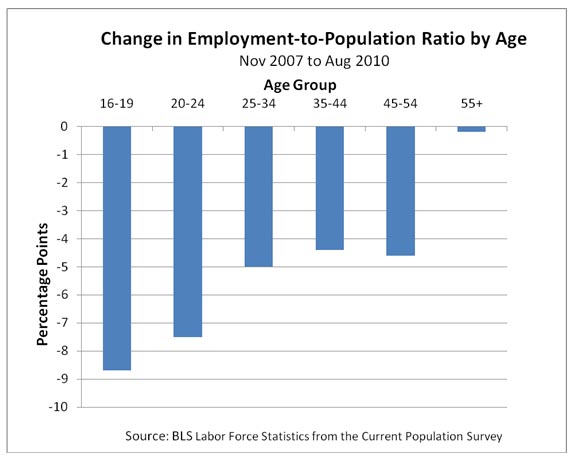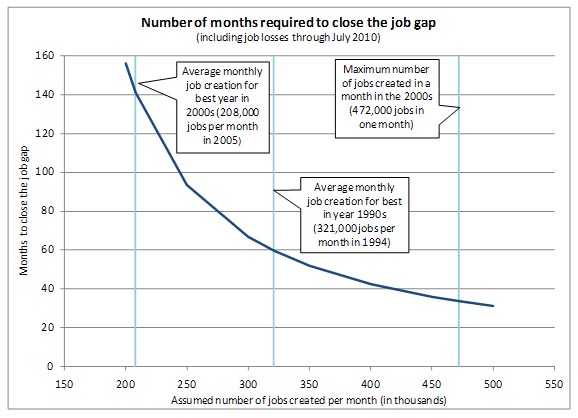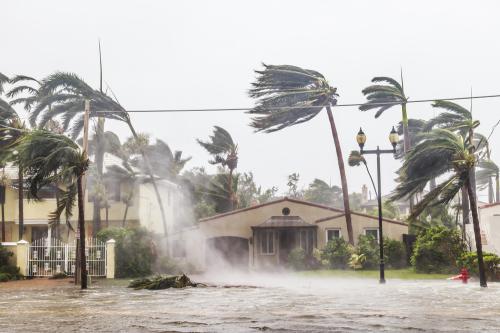The August employment numbers reflect the slow pace of the economy’s journey toward recovery. Overall, the U.S. economy continued to shed jobs as employment fell by 54,000 last month. In the private sector, however, businesses added 67,000 jobs, continuing a trend of lukewarm growth that began eight months ago.
As we have done for the past few months, The Hamilton Project continues to explore the “job gap,” which measures the number of jobs the economy needs to create to return to pre-recession employment levels while also absorbing the 125,000 people who typically enter the labor force each month. In this month’s post, we also dig deeper into the employment numbers to see how the Great Recession has impacted different age groups.
How Do Age Groups Compare?
The Hamilton Project’s most striking finding is that America’s youngest workers have been hit hardest by the Great Recession. To be more specific, younger age groups (ages 16 to 19 and 20 to 24) have experienced the most drastic drop in employment as measured by the employment-to-population ratio. In contrast, there has been almost no change in the share of older workers employed—the employment-to-population ratio for people 55 and older has barely dropped.
The chart below illustrates the disproportionate impact that the Great Recession has had on younger workers in the United States:

Evidence from the Job Opening and Labor Turnover Survey (JOLTS) helps explain this story. During the current recession both job openings and the number of people quitting their job (“quits”) plunged to extremely low levels. Very few older workers have left their jobs and are instead working longer and retiring later—perhaps in response to the recession’s effect on retirement savings and wealth. For younger Americans, such as new high school and college graduates, this has meant fewer opportunities to find work.
For these young adults just entering the labor market for the first time, the impacts of the recession will last well into the future. According to one study (Kahn 2010), young people graduating from college during today’s severe recession will earn approximately 17.5 percent less per year than comparable peers graduating in better labor markets. This lower wage effect is highly persistent, fading away only after 17 years of work.
What does this mean in terms of lost income? For the average college graduate this year, this translates into approximately $70,000 (in today’s dollars) in lost earnings over the next decade. For the 2008, 2009, and 2010 classes combined that amounts to over $330 billion in lost earnings over 10 years. The projected losses are even larger for graduates who cannot find a job upon graduation.
The Job Gap
Based on the August employment numbers the job gap grew to 11.7 million jobs, up from July’s gap of 11.6 million jobs.
To help put this in context, the graph below shows how long it will take to fill the job gap at different rates of job creation. If the economy adds about 208,000 jobs per month (the average monthly rate for the best year of job creation in the 2000s) then it will take almost 12 years to close the job gap. At a more optimistic rate of 321,000 jobs per month (the average monthly rate for the best year of the 1990s) the economy will reach pre-recession employment levels only after five years.

The road to full recovery will indeed be long and may be rocky for many Americans. For America’s youth, the repercussions of the recession are projected to last far into the future. Even after the Great Recession has officially come to an end, additional efforts may be needed to help unwind these long-term effects.
At a December 3rd event in Washington, DC, the Hamilton Project, in partnership with the Center for American Progress, will unveil several new policy proposals to help address the current employment situation. It is clear that new thinking and new ideas are needed to face the challenges ahead.
The Brookings Institution is committed to quality, independence, and impact.
We are supported by a diverse array of funders. In line with our values and policies, each Brookings publication represents the sole views of its author(s).



Commentary
The Long-term Effects of the Great Recession for America’s Youth
September 3, 2010